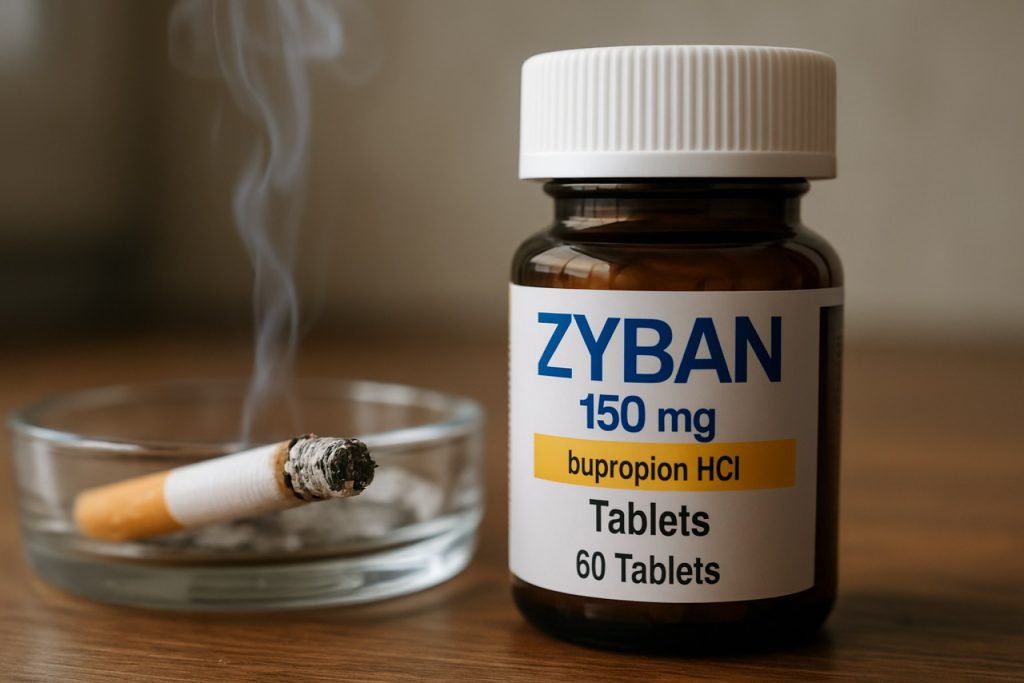
Unlocking the Power of Zyban (Bupropion) in Smoking Cessation Therapy: How This Prescription Medication is Transforming Quit Rates and Shaping the Future of Tobacco Addiction Treatment. (2025)
- Introduction: The Urgent Need for Effective Smoking Cessation Therapies
- Zyban (Bupropion) Overview: Mechanism of Action and Clinical Profile
- Comparative Efficacy: Zyban Versus Other Smoking Cessation Aids
- Safety Profile and Side Effects: What Clinicians and Patients Should Know
- Patient Selection: Who Benefits Most from Zyban Therapy?
- Guidelines and Regulatory Status: Approvals and Recommendations (FDA, CDC)
- Real-World Outcomes: Success Rates and Patient Experiences
- Market Trends and Public Interest: Adoption Rates and Forecasts (2024–2030)
- Emerging Research: Innovations and Future Directions in Bupropion-Based Therapies
- Conclusion: The Evolving Role of Zyban in Combating Tobacco Dependence
- Sources & References
Introduction: The Urgent Need for Effective Smoking Cessation Therapies
Tobacco use remains a leading cause of preventable morbidity and mortality worldwide, with the World Health Organization (WHO) estimating over 8 million deaths annually attributable to smoking-related diseases. Despite decades of public health campaigns and regulatory measures, global smoking prevalence continues to pose a significant challenge, particularly in low- and middle-income countries. In 2025, the urgency for effective smoking cessation therapies is underscored by persistent high relapse rates and the complex neurobiological underpinnings of nicotine dependence. Traditional behavioral interventions, while beneficial, often yield modest long-term abstinence rates, highlighting the necessity for adjunctive pharmacological options.
Zyban, the brand name for bupropion, is a non-nicotine prescription medication that has been approved for smoking cessation in numerous countries, including the United States and the European Union. Originally developed as an antidepressant, bupropion’s efficacy in reducing nicotine cravings and withdrawal symptoms has positioned it as a cornerstone in pharmacotherapy for tobacco dependence. The U.S. Food and Drug Administration (FDA) and the European Medicines Agency (EMA) both recognize bupropion as a first-line treatment for individuals seeking to quit smoking, often in combination with behavioral support programs.
Recent data from clinical trials and real-world studies continue to affirm the effectiveness of bupropion in increasing quit rates compared to placebo, with meta-analyses indicating that it approximately doubles the likelihood of long-term abstinence. The medication’s unique mechanism—modulating dopaminergic and noradrenergic pathways—addresses both the psychological and physiological aspects of addiction, making it particularly valuable for individuals who have not succeeded with nicotine replacement therapies alone. In 2025, ongoing research is focused on optimizing dosing regimens, minimizing side effects, and identifying patient populations most likely to benefit from bupropion-based interventions.
Looking ahead, the integration of bupropion into comprehensive cessation strategies is expected to expand, especially as healthcare systems prioritize preventive care and chronic disease management. The World Health Organization and national health agencies continue to advocate for broader access to evidence-based cessation aids, including bupropion, as part of their tobacco control frameworks. As the landscape of nicotine delivery evolves—with the rise of e-cigarettes and novel tobacco products—the role of established pharmacotherapies like Zyban remains critical in supporting individuals on their path to quitting smoking.
- World Health Organization
- U.S. Food and Drug Administration
- European Medicines Agency
Zyban (Bupropion) Overview: Mechanism of Action and Clinical Profile
Zyban, the brand name for bupropion hydrochloride, is a prescription medication primarily indicated for smoking cessation therapy. Originally developed as an antidepressant, bupropion was later found to be effective in helping individuals quit smoking, leading to its approval for this indication by regulatory agencies such as the U.S. Food and Drug Administration and the European Medicines Agency. As of 2025, Zyban remains one of the few non-nicotine pharmacotherapies available for tobacco dependence.
The mechanism of action of bupropion in smoking cessation is distinct from nicotine replacement therapies. Bupropion acts as a norepinephrine-dopamine reuptake inhibitor (NDRI), increasing the synaptic concentrations of these neurotransmitters in the central nervous system. This modulation is believed to reduce nicotine withdrawal symptoms and cravings, as well as to blunt the reinforcing effects of nicotine on the brain’s reward pathways. Additionally, bupropion exhibits antagonistic activity at nicotinic acetylcholine receptors, which may further diminish the rewarding effects of smoking.
Clinically, Zyban is typically prescribed as a sustained-release tablet, with treatment initiated one to two weeks before the target quit date. The standard regimen involves a gradual titration to minimize the risk of adverse effects, such as insomnia or dry mouth. Numerous randomized controlled trials and meta-analyses have demonstrated that bupropion approximately doubles the likelihood of long-term smoking abstinence compared to placebo, with efficacy comparable to or slightly lower than varenicline, another non-nicotine pharmacotherapy (Cochrane).
The safety profile of Zyban is well-characterized. The most common side effects include insomnia, dry mouth, and headache. A rare but serious risk is seizure, particularly in individuals with predisposing factors such as a history of seizures or eating disorders. As a result, bupropion is contraindicated in these populations. Ongoing pharmacovigilance by agencies such as the U.S. Food and Drug Administration continues to monitor for adverse events and update prescribing information as needed.
Looking ahead to the next few years, Zyban is expected to maintain its role as a first-line pharmacological option for smoking cessation, especially for patients who prefer non-nicotine therapies or have contraindications to other agents. Research is ongoing into optimizing dosing strategies, combination therapies, and identifying patient subgroups most likely to benefit from bupropion. As global public health initiatives intensify efforts to reduce tobacco use, Zyban’s established clinical profile and unique mechanism of action will likely ensure its continued relevance in comprehensive smoking cessation programs.
Comparative Efficacy: Zyban Versus Other Smoking Cessation Aids
In 2025, the comparative efficacy of Zyban (bupropion) versus other smoking cessation aids remains a central focus in tobacco dependence treatment. Zyban, a non-nicotine prescription medication, acts as a norepinephrine-dopamine reuptake inhibitor and is approved for smoking cessation by major regulatory agencies, including the U.S. Food and Drug Administration and the European Medicines Agency. Its efficacy is often compared to other first-line therapies such as nicotine replacement therapy (NRT) and varenicline.
Recent meta-analyses and clinical guidelines continue to support Zyban’s effectiveness. According to the Centers for Disease Control and Prevention, bupropion approximately doubles the chances of quitting compared to placebo, with quit rates at six months ranging from 19% to 26%. This is comparable to NRT, which also doubles cessation rates, but slightly lower than varenicline, which can achieve quit rates of 25% to 35%. The National Health Service in the UK and the CDC both recognize bupropion as a recommended pharmacotherapy, particularly for individuals who prefer a non-nicotine option or have contraindications to other medications.
Head-to-head trials and systematic reviews published in the last two years reinforce these findings. Varenicline generally demonstrates higher efficacy than bupropion, with a relative risk of abstinence at six months favoring varenicline by approximately 1.3 times. However, bupropion remains a valuable alternative, especially for patients with depressive symptoms, as it also serves as an antidepressant. Combination therapies, such as bupropion plus NRT, are being explored in ongoing studies and may offer incremental benefits, though the evidence is still emerging.
Safety profiles are also a consideration in comparative efficacy. Bupropion is associated with a risk of insomnia, dry mouth, and, rarely, seizures, but lacks the neuropsychiatric warnings that were previously attached to varenicline. Regulatory agencies such as the FDA have updated safety communications, clarifying that both drugs are generally safe for most users, though individual risk assessment remains essential.
Looking ahead, the role of Zyban in smoking cessation is expected to remain stable, particularly as part of personalized treatment strategies. Ongoing research into genetic and behavioral predictors of response may further refine its use. As digital health interventions and telemedicine expand, access to prescription aids like Zyban is likely to improve, supporting broader public health efforts to reduce tobacco use globally.
Safety Profile and Side Effects: What Clinicians and Patients Should Know
Zyban (bupropion) remains a widely prescribed pharmacological aid for smoking cessation, with its safety profile and side effect spectrum continuing to be closely monitored by regulatory agencies and clinical researchers. As of 2025, bupropion is approved for smoking cessation in several countries, including the United States and the United Kingdom, and is available by prescription. Its mechanism as a norepinephrine-dopamine reuptake inhibitor distinguishes it from nicotine replacement therapies, offering an alternative for individuals who have not succeeded with other methods.
The most commonly reported side effects of Zyban in smoking cessation therapy include insomnia, dry mouth, headache, and nausea. These effects are generally mild to moderate and tend to diminish as treatment progresses. However, clinicians are advised to monitor for more serious adverse events, such as seizures, which, while rare (incidence approximately 0.1% at recommended doses), remain a significant concern. The risk of seizure is dose-dependent and increases in patients with predisposing factors such as a history of seizures, eating disorders, or concurrent use of other medications that lower the seizure threshold. As a result, current guidelines emphasize careful patient selection and adherence to recommended dosing regimens.
Neuropsychiatric side effects, including mood changes, agitation, and suicidal ideation, have been a focus of regulatory review. In 2024, the U.S. Food and Drug Administration reaffirmed the importance of monitoring for these symptoms, particularly in patients with a history of psychiatric illness. The Medicines and Healthcare products Regulatory Agency in the UK similarly advises clinicians to counsel patients about potential neuropsychiatric risks and to provide close follow-up during the initial weeks of therapy.
Recent post-marketing surveillance and real-world studies continue to support the overall safety of bupropion for smoking cessation, with no new major safety signals identified as of early 2025. Ongoing pharmacovigilance efforts by agencies such as the European Medicines Agency are expected to further clarify the long-term safety profile as more data become available. Looking ahead, the outlook for Zyban’s use in smoking cessation remains positive, provided that clinicians adhere to established safety protocols and individualize therapy based on patient risk factors.
- Common side effects: insomnia, dry mouth, headache, nausea
- Serious risks: seizures (rare, dose-dependent), neuropsychiatric symptoms
- Contraindications: seizure disorders, eating disorders, abrupt alcohol or sedative withdrawal
- Regulatory agencies stress patient education and close monitoring
Patient Selection: Who Benefits Most from Zyban Therapy?
Zyban (bupropion) remains a key pharmacological option for smoking cessation, with ongoing research in 2025 refining the understanding of which patient populations benefit most from its use. Zyban is a non-nicotine prescription medication that acts as a norepinephrine-dopamine reuptake inhibitor, reducing withdrawal symptoms and the urge to smoke. Its efficacy and safety profile have been established in multiple randomized controlled trials, and it is included in clinical guidelines for tobacco dependence treatment by major health authorities such as the Centers for Disease Control and Prevention and the National Health Service.
Current evidence indicates that Zyban is particularly beneficial for adult smokers who have previously failed to quit using nicotine replacement therapy (NRT) or who prefer a non-nicotine-based approach. It is also recommended for individuals with a history of depression, as bupropion’s antidepressant properties may provide dual benefits in this subgroup. Recent studies have highlighted that patients with comorbid psychiatric conditions, such as anxiety or depressive disorders, may experience improved cessation rates with Zyban compared to NRT alone, provided there are no contraindications such as a history of seizures or eating disorders.
In 2025, patient selection is increasingly guided by personalized medicine approaches. Genetic and behavioral markers are being investigated to predict which individuals are most likely to respond to bupropion. For example, ongoing research supported by the National Institutes of Health is exploring pharmacogenomic factors that may influence bupropion metabolism and efficacy, aiming to tailor therapy to individual patient profiles in the coming years.
Zyban is generally not recommended for pregnant women, adolescents, or individuals with a seizure disorder, as outlined by the U.S. Food and Drug Administration. Careful screening for contraindications, including current or past eating disorders and concurrent use of monoamine oxidase inhibitors, remains essential. In clinical practice, Zyban is often considered for patients who have not succeeded with first-line therapies or who have specific clinical characteristics that suggest a higher likelihood of benefit.
Looking ahead, the integration of digital health tools and remote monitoring is expected to further refine patient selection and support adherence to Zyban therapy. As research continues, clinicians are likely to have access to more precise algorithms and decision aids to identify those who will benefit most from bupropion-based smoking cessation interventions.
Guidelines and Regulatory Status: Approvals and Recommendations (FDA, CDC)
Zyban (bupropion hydrochloride) remains a cornerstone pharmacotherapy for smoking cessation, with its regulatory and guideline status firmly established in the United States and internationally. The U.S. Food and Drug Administration (FDA) first approved Zyban in 1997 as a non-nicotine prescription medication for aiding smoking cessation. As of 2025, Zyban continues to be an FDA-approved option, with its labeling and safety information periodically updated to reflect new evidence and post-marketing surveillance data. The FDA maintains oversight of bupropion’s risk profile, including neuropsychiatric adverse events, and requires boxed warnings regarding these risks. However, the overall benefit-risk balance remains favorable for its use in motivated adults seeking to quit smoking.
The Centers for Disease Control and Prevention (CDC), as the leading U.S. public health authority, consistently includes bupropion among the recommended first-line pharmacotherapies for tobacco dependence. The CDC’s guidance, updated in collaboration with other federal agencies and expert panels, highlights bupropion’s efficacy in increasing quit rates compared to placebo, especially when combined with behavioral support. The CDC also monitors trends in tobacco use and cessation, providing ongoing surveillance that informs national recommendations.
Internationally, organizations such as the World Health Organization (WHO) and the National Institute for Health and Care Excellence (NICE) in the United Kingdom continue to endorse bupropion as a recommended pharmacological aid for smoking cessation, reflecting a broad consensus on its role in comprehensive tobacco control strategies.
Looking ahead to the next few years, no major changes in the regulatory status of Zyban are anticipated, though ongoing pharmacovigilance may prompt further refinements in labeling or patient selection criteria. The FDA and CDC are expected to continue supporting bupropion’s use, particularly as part of multi-modal cessation programs. There is also growing interest in optimizing guidelines for special populations, such as individuals with comorbid psychiatric conditions, where bupropion’s dual antidepressant and smoking cessation properties may offer unique benefits. As new data emerge, especially from real-world studies and digital health interventions, regulatory bodies and guideline committees will likely update their recommendations to ensure safe and effective use of Zyban in diverse patient populations.
Real-World Outcomes: Success Rates and Patient Experiences
Zyban (bupropion), an atypical antidepressant, continues to be a key pharmacological option for smoking cessation in 2025, with real-world outcomes reflecting both its efficacy and patient experiences. As of this year, Zyban remains approved for smoking cessation by major regulatory agencies, including the U.S. Food and Drug Administration and the European Medicines Agency. Its use is often compared to other first-line therapies such as varenicline and nicotine replacement therapy (NRT).
Recent observational studies and registry data indicate that Zyban achieves quit rates of approximately 20–25% at six months post-quit date, when combined with behavioral support. These rates are consistent with, though slightly lower than, those reported for varenicline, but higher than placebo or unaided attempts. Real-world data from national health services, such as the National Health Service in the UK, show that bupropion remains a commonly prescribed option, particularly for individuals who have contraindications to other therapies or who have previously failed with NRT.
Patient experiences with Zyban are mixed but generally positive among those who tolerate the medication. Commonly reported benefits include reduced cravings and withdrawal symptoms, which are critical factors in successful cessation. However, side effects such as insomnia, dry mouth, and, less commonly, neuropsychiatric symptoms, continue to be reported and can lead to discontinuation in a minority of users. Importantly, the risk of serious adverse events, such as seizures, remains low but is a consideration in clinical decision-making, as highlighted in ongoing safety monitoring by the U.S. Food and Drug Administration.
- Recent patient surveys and qualitative studies suggest that individuals value the non-nicotine mechanism of Zyban, especially those concerned about continued nicotine dependence.
- Adherence remains a challenge, with real-world discontinuation rates of up to 30% within the first month, often due to side effects or perceived lack of efficacy.
- Healthcare providers are increasingly using digital tools and telemedicine to support adherence and monitor side effects, a trend expected to grow in the next few years.
Looking ahead, ongoing research is focused on optimizing patient selection for Zyban therapy, including genetic and behavioral predictors of response. As digital health integration expands, real-world data collection on patient outcomes and experiences is expected to become more robust, informing best practices and potentially improving success rates for smoking cessation with Zyban.
Market Trends and Public Interest: Adoption Rates and Forecasts (2024–2030)
As of 2025, the use of Zyban (bupropion) in smoking cessation therapy continues to be a significant component of pharmacological strategies aimed at reducing tobacco dependence. Zyban, originally developed as an antidepressant, was one of the first non-nicotine medications approved for smoking cessation and remains a recommended option in clinical guidelines. The U.S. Food and Drug Administration (FDA) and the National Health Service (NHS) in the United Kingdom both list bupropion as an approved therapy for individuals seeking to quit smoking.
Recent data indicate that while the overall market share of Zyban has declined compared to its peak in the early 2000s, it maintains a stable presence, particularly among patients who have contraindications to nicotine replacement therapy (NRT) or who have not succeeded with other first-line treatments. According to the Centers for Disease Control and Prevention (CDC), bupropion is prescribed in approximately 10–15% of pharmacotherapy-assisted quit attempts in the United States as of 2024, with similar rates observed in several European countries.
Market trends from 2024 through 2030 suggest a modest but steady demand for Zyban, driven by several factors:
- Increasing awareness of the health risks associated with smoking and the benefits of cessation, supported by ongoing public health campaigns from organizations such as the World Health Organization (WHO).
- Continued inclusion of bupropion in national and international smoking cessation guidelines, which reinforces its role as a viable alternative to NRT and varenicline.
- Growing interest in combination therapies, where bupropion is used alongside behavioral interventions or other pharmacotherapies to improve quit rates.
However, the outlook for Zyban is tempered by the emergence of newer therapies and the increasing popularity of digital health interventions, such as mobile cessation apps and telemedicine support, which may shift patient preferences. Additionally, the expiration of key patents has led to the widespread availability of generic bupropion, making the therapy more accessible but also reducing brand-specific market share.
Forecasts through 2030 anticipate that Zyban and its generics will continue to play a supportive, though not dominant, role in smoking cessation. Adoption rates are expected to remain stable or experience slight growth, particularly in regions with robust healthcare infrastructure and reimbursement policies for cessation medications. Ongoing research into personalized medicine and pharmacogenomics may further refine patient selection for bupropion, potentially enhancing its effectiveness and appeal in targeted populations.
Emerging Research: Innovations and Future Directions in Bupropion-Based Therapies
As of 2025, research into bupropion-based therapies, particularly Zyban, continues to evolve, reflecting both the ongoing need for effective smoking cessation interventions and the expanding understanding of neuropharmacology. Zyban (bupropion hydrochloride), originally developed as an antidepressant, has been approved for smoking cessation for over two decades. Its mechanism—primarily as a norepinephrine-dopamine reuptake inhibitor—remains a focus of investigation, especially as researchers seek to optimize efficacy and minimize side effects.
Recent clinical trials are exploring novel dosing regimens and combination therapies. For example, studies are underway to assess the synergistic effects of bupropion with varenicline or nicotine replacement therapies, aiming to improve quit rates among populations with high relapse risk. Early data suggest that tailored combination approaches may enhance abstinence rates, particularly in individuals with comorbid psychiatric conditions or those who have previously failed monotherapy. These studies are being conducted under the oversight of regulatory bodies such as the U.S. Food and Drug Administration and the National Health Service in the UK, both of which continue to monitor post-marketing safety and efficacy.
Genetic and biomarker-driven personalization is another emerging direction. Researchers are investigating how genetic polymorphisms affecting bupropion metabolism (notably CYP2B6 variants) may influence therapeutic outcomes. The goal is to develop precision medicine approaches that identify which patients are most likely to benefit from Zyban, thereby reducing trial-and-error prescribing and improving overall success rates. This aligns with broader trends in pharmacogenomics, as highlighted by organizations such as the National Institutes of Health.
Digital health integration is also gaining momentum. Mobile applications and telemedicine platforms are being paired with bupropion therapy to provide real-time support, adherence monitoring, and behavioral interventions. These digital adjuncts are being evaluated in large-scale studies, with early results indicating improved medication adherence and higher quit rates compared to standard care.
Looking ahead, the outlook for bupropion-based smoking cessation therapies is promising. Ongoing research is expected to yield more individualized, effective, and accessible interventions. Regulatory agencies and public health organizations, including the Centers for Disease Control and Prevention, continue to emphasize the importance of evidence-based cessation strategies, ensuring that innovations in bupropion therapy are rigorously evaluated and widely disseminated in the coming years.
Conclusion: The Evolving Role of Zyban in Combating Tobacco Dependence
As of 2025, Zyban (bupropion) continues to play a significant, though evolving, role in the landscape of smoking cessation therapy. Since its approval for this indication, Zyban has been recognized for its dual action as both an antidepressant and a non-nicotine aid for tobacco dependence, offering an alternative for individuals who may not tolerate or respond to nicotine replacement therapies. Its mechanism—modulating neurotransmitters such as dopamine and norepinephrine—remains relevant, particularly for patients with comorbid depressive symptoms or those seeking a non-nicotine pharmacological approach.
Recent years have seen a growing emphasis on personalized medicine in tobacco dependence treatment. Clinical guidelines from leading authorities, such as the Centers for Disease Control and Prevention and the U.S. Food and Drug Administration, continue to include bupropion as a first-line pharmacotherapy option, often in combination with behavioral support. Meta-analyses and systematic reviews published through 2024 confirm that bupropion increases quit rates compared to placebo, with efficacy comparable to other approved medications, such as varenicline and nicotine replacement therapies. However, the choice of therapy is increasingly guided by patient-specific factors, including psychiatric history, contraindications, and previous quit attempts.
The outlook for Zyban’s role in smoking cessation is shaped by several trends. First, the integration of digital health tools and telemedicine is expanding access to prescription therapies, including bupropion, especially in underserved populations. Second, ongoing research is exploring combination regimens—such as bupropion with varenicline or nicotine patches—to enhance quit rates, with preliminary data suggesting potential benefits for highly dependent smokers. Third, regulatory agencies like the European Medicines Agency and the U.S. Food and Drug Administration are closely monitoring post-marketing safety data, particularly regarding neuropsychiatric side effects, to ensure continued safe use.
Looking ahead, Zyban is expected to maintain its place as a valuable component of comprehensive tobacco dependence treatment, particularly for specific patient subgroups. Its established efficacy, non-nicotine mechanism, and compatibility with emerging digital health interventions position it as a flexible option in the evolving fight against tobacco use. Continued surveillance, research, and guideline updates from authoritative bodies will further define Zyban’s optimal use in the coming years, ensuring that it remains a relevant tool in global tobacco control strategies.
Sources & References
- World Health Organization
- European Medicines Agency
- Cochrane
- Centers for Disease Control and Prevention
- National Health Service
- National Institutes of Health
- National Institute for Health and Care Excellence (NICE)



